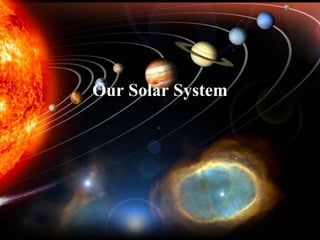
Solar System.ppt
- 2. Journal • Can you name the 8 planets in our Solar System? This includes Earth… Mercury, Venus, Earth, Mars, Jupiter, Saturn, Uranus, Neptune
- 3. Do you know any ways to remember all 8? • My Very Excellent Mother Just Sold Us Nuggets!
- 4. Galaxies • Our sun is 1 of trillions of stars in the universe. Stars are found in groups held together by gravity. • A huge group of stars is called a galaxy. • Our entire universe is made up of thousands of galaxies. • The images below show you how small we are compared to the entire universe. UNIVERSE GALAXY SOLAR SYSTEM The entire universe is made of thousands of galaxies A huge group of stars held together by gravity. A system of planets & stars that are found throughout galaxies
- 5. The Milky Way • Our Solar System is part of the “Milky Way” galaxy.
- 6. BRAIN POP • GALAXY – http://www.brainpop.com/science/space/galaxie s/ • MILKY WAY – http://www.brainpop.com/science/space/milky way/ • SOLAR SYSTEM – http://www.brainpop.com/science/space/solarsy stem/
- 7. The Inner Planets (Terrestrial Planets)
- 8. Spinning Planets • Period of Rotation: amount of time that an object takes to rotate once. (1 Day) • Period of Revolution: time it takes an object to revolve around the sun once. (1 year) http://www.youtube.com/watch?v=97Ob0x R0Ut8&feature=related
- 9. Mercury • On Mercury you weigh only 38% of what you weigh on Earth. • Fastest orbiting planet • Planet nearest to the sun • One side of the planet can be 800 degrees Fahrenheit when the other can be -280 degree Fahrenheit at the same time.
- 10. Venus • On Venus you weigh only 91% of what you weigh on Earth. • Venus has 90 times the pressure of Earth • Venus has volcanoes like Earth • Rotates in the opposite direction of Earth. • One time there were oceans before they boiled away.
- 11. Earth • 23 hours and 56 min=1 Earth day (rotation) • 365 days =1 Earth year (revolution) • Earth is warm enough to keep most of its water from freezing and cold enough to keep it’s water from boiling • Temperature is between –13 degrees Celsius and 37 degrees Celsius
- 12. Mars • Air Pressure on Mars is the same as 30 km above the Earth’s surface • Mars is in the form of ice. • Evidence that water was there at one time • Volcanic history like Earth. • It has the tallest mount of the planets (Olympus Mons) 3x’s size of Mt. Everest.
- 13. Outer Planets (Gas Planets or Jovial Planets)
- 14. Jupiter • Largest planet in the Solar System • Has a Great Red Spot from a storm system that is more than 400 years old (It is larger than Earth!) • 9 hours and 54 min=1 Jupiter day (shortest day) • Pressure is so great it would crush a spaceship.
- 15. Saturn • 2nd Largest planet in the Solar System • 95 times more massive than earth. • Saturn has the largest rings of any planet, the rings are made of icy particles. • Most moons of any planet.
- 16. Uranus • Discovered in 1781 • Uranus appears blue-green in color • It’s axis of rotation is tilted 90 degrees • Moons are named after Shakespearean plays and formed from other broken moons.
- 17. Neptune • Discovered in 1846 • Neptune has visual belts of clouds • Interior releases thermal energy to its outer layers. • Use to be the 8th planet after Pluto until 1999.
- 18. What Keeps Our Planets & Other Objects In Space In Orbit?? GRAVITY & INERTIA
- 19. GRAVITY & INERTIA • Gravity – A force that pulls all objects toward each other. • Inertia – The tendency of an object to stay either at rest or in motion along a straight path So how does these 2 forces keep everything in orbit? **Example: The picture to the right shows how inertia & gravity work together to keep the moon orbiting the Earth. Actual Orbit
- 20. GRAVITY & INERTIA If inertia was stronger than gravity then objects would stay on their straight path & fly off into space. Actual Orbit If gravity was stronger than inertia then objects would crash Inertia & gravity work together to keep the moon orbiting the Earth. And they work together to keep planets orbiting the sun
- 22. What is a comet? • A comet is a small body made out of dust, rock, gas & ice. • They are kind of like a dirty snowball • Comets come from faraway regions of our solar system beyond the planets
- 23. Comets are made up of different parts. Comet Brain Pop http://www.brainpop.com/science/space/comets/ The nucleus The coma The ion tail The dust tail
- 24. What is an asteroid? • Asteroids are large pieces of space rock with irregular shapes. • They are also known as planetoids or minor planets that revolves around our sun
- 25. • Most asteroids orbit the Sun in the asteroid belt located between Mars and Jupiter. A few asteroids approach the Sun more closely. • Asteroids can collide with object such as Earth’s moon, creating huge craters on the surface. 3 to 6 Asteroid Brain Pop http://www.brainpop.com/sc ience/space/asteroids/
- 26. • Meteoroids are pieces of rock or dust that are smaller than asteroids. • Meteoroids are tiny particles left by an asteroid or a comet & most meteoroids are smaller than the size of a pebble. METEOROIDS METEORS & METEORITES
- 27. • When small meteoroids enters Earth’s atmosphere, they usually burn up & make a fiery trail as it falls, it is then called a meteor or a “shooting star” • Meteors that land on Earth are called meteorites.